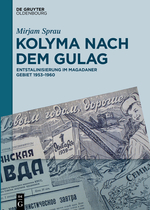Mirjam Sprau
Kolyma after the GULAG. De-Stalinization in the Magadan region, 1953-1960
DeGruyter, Oldenburg 2018, ISBN 978-3-11-068254-0
Until 1953, the entire northeast of the USSR (from the Kolyma region to the Bering Strait with the capital Magadan) was conceived as a "big camp": its exploration and exploitation was exclusively put in practice through forced labor, dominated by the organs of the secret police (NKVD-MVD). However, within a few years after Stalin's death, the CPSU had prevailed in a power struggle against the MVD, free workers were engaged in mechanized industry, and a new infrastructure emerged – prisoner barracks became kindergartens, prison cells became bathhouses. This study describes how the radical change was supported by propaganda and social policy, and how the relationship of the regional elite to contract workers changed in comparison to prisoners. It also shows the enormous burdens on everyday life that the transformation in the permafrost region brought along. De-Stalinization is discussed as a development strategy for a camp area that remains a symbol of Stalinism to this day.
Country Analytical Digests
» Eastern Europe - Analytical Digests (free subscription + online archive)
Discuss Data
Archiving, sharing and discussing research data on Eastern Europe, South Caucasus and Central Asia
online specials on
» Talking Archives
» Russian street art against war
» Duma debates (in Russian)
» Putin's speeches
» Protest in Russia
» Annexation of Crimea

